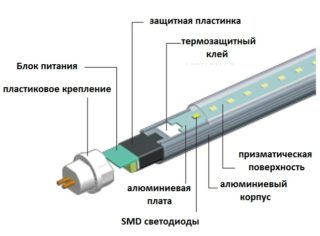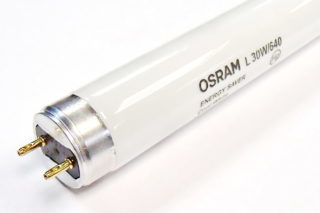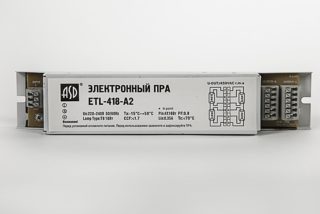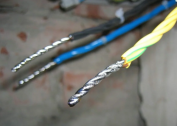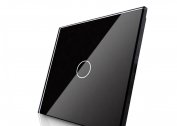In the assortment of modern ceiling and wall lamps, models equipped with linear (tubular) lamps are represented quite widely. They are installed not only in offices, factory floors and public places, but also in residential premises. In everyday life, they are often used to illuminate aquariums and other special areas where diffused light is needed. Not so long ago, only fluorescent illuminators (LL) were used as a source in them, but today they have been replaced by a more advanced T8 LED lamp. It is useful for users to find out which of these two options is better and what needs to be done to replace the LL with an LED analog without changing the housing of the lamp itself.
Construction and base
Lamps of a typical design T8 are made in the form of a tube with a diameter of 25.4 mm, at the ends of which there are pins spaced 13 mm apart. Together with the end cap of the tubular bulb, they form a base through which the operating voltage is supplied, while simultaneously fixing the product in the lamp housing.
The most popular tube samples are 600 and 900 mm long. Luminaires equipped with two lamps of this length are installed everywhere. Products offered by the market with long fluorescent tubes of 1.2 and 1.5 meters are much less common and are used mainly in industrial facilities and, if necessary, illuminate large spaces.
Miniature devices of non-standard length are used for local lighting, providing the user with comfort and coziness.
Types and characteristics of lamps
In the domestic market there are two classes of tubular products of standard T8. These are fluorescent and LED light bulbs. Despite the apparent similarity of the tubes of various types, their operating principles differ radically.
T8 fluorescent tubes
This type of lighting fixture is the most common example of a group called fluorescent lamps or LDS. Their flask is filled with mercury vapor, which, when a glow discharge is ignited, emits ultraviolet radiation close to a blue glow. It acts on the phosphor, which in the manufacture of the flask is applied from its inner side. As a result, the coating begins to glow, and part of the UV spectrum that is harmful to the eyes is absorbed in the body of the glass tube.
To start and maintain combustion, two spiral-shaped electrodes are used, the voltage to which is supplied through the connectors G13 available on the ends of the tube. To control the flow of the discharge in the bulb, which should not go into an uncontrolled arc process, the current through the gap is limited by taking special measures. For this, an electronic or electromagnetic electronic ballast regulating device (the so-called "ballast") is used, which simultaneously provides easy lamp start-up. This working unit, built directly into the lamp, is designed to work immediately with two tubes of 18 watts each.
T8 LED Bulbs
In LED fluorescent lamps, unlike LL, mercury and a phosphor are not used, the radiation is formed by semiconductor LEDs located inside the bulb. Their total number is determined by the requirements for obtaining the required light output (radiation power), and also depends on the dimensions of the lamp. Two varieties of LED illuminators with a typical size of T8 are known:
- Models with integrated driver.
- Products capable of working without it.
The former do not need additional devices, which allows you to connect them directly to a 220 Volt network. The second type does not contain an integrated driver, so for their work you need a separate power supply. With its help, it is possible to convert 220 volts to a voltage suitable for powering LEDs.
Which illuminator is better
To choose the appropriate option, you need to compare the advantages of the models, and then draw a final conclusion. The comparison results can be represented as follows:
- the main advantage of LL tubes T8 (their efficiency and durability) more than overlap LED counterparts;
- for powering fluorescent products, starting equipment is needed, the cost of which is comparable to the price of a LED lamp;
- Electronic ballasts very often fail, and this involves additional costs;
- The main disadvantage of LED lamps - their high cost - eventually disappears, since semiconductors are rapidly becoming cheaper with an increase in the mass of goods produced.
In modern conditions, it is preferable to purchase LED tubular fluorescent lamps, the sizes of which do not differ from the same indicators for LL.
As an exception, we consider a situation when it is impossible or very difficult to exchange fluorescent lamps for LED analogues due to the peculiarities of their design.
Replacing T8 fluorescent lamps with their LED counterparts
The tubes of these lamps have the same dimensions and are equipped with identical connectors. This similarity greatly simplifies their replacement and connection, which are made directly in the lamp. In this case, if there is already a finished case product, it is enough to buy an LED sample and put it in the place of the old lamp.
Seat selection

You can’t just take and remove one lamp from the lamp socket, and then put another in its place. In addition to this, it will be necessary to change the electrical circuit, which is provided for in the design of the existing lighting device. Despite the fact that it seems difficult for some users, anyone who is familiar with the basics of electricians can update the electric filling.
First of all, you need to understand how the LED lamp is connected to the network. Depending on the embodiment, it is connected in two ways:
- in the first case, voltage is applied to the right or left base (on the one hand) at once on both pins;
- in another version, the network wire is connected from two sides of the tube to different socles in which only one pin is involved.
The design of the first products usually does not provide an integrated driver. The samples of the second type have an electronic control circuit that allows you to connect them directly to the 220 Volt network.
In the assortment of individual manufacturers there are models that can be connected to the network regardless of the presence of an integrated driver. Before buying, you should check with the seller how to switch the lamp, and also find out what voltage it is designed for.
Connecting a T8 LED lamp
The easiest way is to replace the LDS with an LED analog if the new lamp already has a built-in driver. In this case, you will have to perform the following simple operations:
- Remove the starter from the socket.
- Short-circuit the electromagnetic inductor.
- Since it is not involved in the power supply process, it is allowed to completely dismantle it from the lamp.
- As a result of these actions, a voltage of 220 volts will be supplied to the pins of the socles located at different ends of the lamp.
When only an LED sample without a driver is available, this electronic device will need to be purchased. We will have to slightly modify the scheme of a standard fluorescent lamp:
- One conductor going from the 220 Volt network to the electromagnetic inductor is disconnected.
- The disconnected end is thrown to the driver terminal to which the starter removed from it was connected.
- All mains voltage will be applied to the electronic device that controls the operation of the LED lamp.
Everyone who is familiar with electrical engineering at the school curriculum level will not be difficult to perform these simple operations.
Selection Guidelines
When buying an LED lamp, attention is drawn to its color temperature, which for devices of this class is measured in Kelvin (K). Not only the state of health of the person who uses it depends on this indicator, but also the comfort of the lighting received. It must be indicated in the accompanying documentation for the purchased product or applied directly to the packaging.
Only after getting acquainted with the features of the device and the operation of the LL and LED lamps, they take up the procedure associated with their replacement. Thanks to this, it is possible to avoid unjustified expenses for the purchase of a new lamp.
